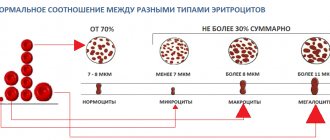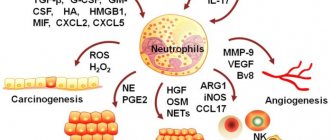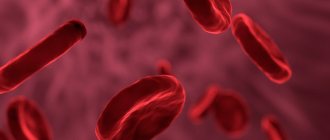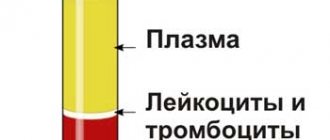Detailed description of the study
ESR, or erythrocyte sedimentation rate, is an indicator that is determined during a general clinical blood test. In an earlier interpretation, the study is called ESR (erythrocyte sedimentation reaction). The essence of the study is to measure the speed at which red blood cells (erythrocytes), after special treatment, settle in a vessel under the influence of gravity. To do this, a substance that prevents clotting (anticoagulant) is added to whole blood after collection. Then it is placed in a thin measuring vessel - a capillary. Red blood cells have a higher specific gravity compared to blood plasma, which serves as the basis for the sedimentation process, that is, the settling of these cells. As a result, the liquid in the capillary is divided into two layers: plasma is in the upper part, red blood cells are in the lower part. The height in millimeters of the top layer formed in the capillary within an hour is an indicator of ESR. The surfaces of red blood cells have the same electrical charge, due to which they do not aggregate in the bloodstream, that is, they do not stick together, but repel each other. If the amount of charge on the membranes decreases, red blood cells are able to connect, like “coin columns”. In this form, the settling process occurs at a faster rate. The strength of the charge on the surface of red blood cells, and therefore the ESR, directly depends on the composition of the blood plasma. Inflammation of any nature leads to an increase in the concentration of the so-called acute phase proteins of inflammation, or acute phase markers (C-reactive protein, haptoglobin and others). These proteins are adsorbed on the surface of red blood cells, reduce the charge of their membranes and thereby lead to the formation of “coin columns”. ESR is often determined in conjunction with a general blood test and leukocyte count during a preventive examination, monitoring the course of inflammatory and infectious diseases, and assessing the effectiveness of treatment. However, the ESR level is a nonspecific indicator that can change not only due to pathological processes in the body, but also depending on certain physiological characteristics. Thus, an increase in ESR is observed during pregnancy and menstruation. In women, the value of this indicator is, on average, higher than in men.
Erythrocyte sedimentation rate (ESR)
A test that evaluates the rate of separation of blood into plasma and red blood cells. The rate of separation is mainly determined by the degree of their aggregation, i.e., the ability to stick together.
Synonyms Russian
Erythrocyte sedimentation reaction, ROE, ESR.
English synonyms
Erythrocyte sedimentation rate, Sed rate, Sedimentation rate, Westergren sedimentation rate.
Research method
Capillary photometry method.
Units
Mm/h (millimeters per hour).
What biomaterial can be used for research?
Venous, capillary blood.
How to properly prepare for research?
- Eliminate alcohol from your diet for 24 hours before the test.
- Do not eat for 2-3 hours before the test (you can drink clean still water).
- Stop taking medications 24 hours before the test (in consultation with your doctor).
- Avoid physical and emotional stress for 30 minutes before the test.
- Do not smoke for 30 minutes before donating blood.
General information about the study
Determination of erythrocyte sedimentation rate (ESR) is an indirect method for identifying inflammatory, autoimmune or oncological diseases. It is performed on a sample of venous or capillary blood, to which a substance has been added that allows it not to clot (anticoagulant). When researching using the Panchenkov method, blood is placed in a thin glass or plastic tube and monitored for an hour. At this time, erythrocytes (red blood cells), as having a large specific gravity, settle, leaving a column of transparent plasma above them. The ESR is calculated based on the distance from the upper boundary of the plasma to the red blood cells. Normally, red blood cells settle slowly, leaving very little pure plasma. For this method, a Panchenkov apparatus is used, consisting of a tripod and capillary pipettes with a 100 mm scale.
For capillary photometry (automatic analyzers ROLLER, TEST1), the kinetic “stopped jet” method is used. At the beginning of the analysis, programmed mixing of the sample occurs in order to disaggregate the red blood cells. Ineffective disaggregation or the presence of microclots can affect the final result, since the analyzer actually measures the kinetics of red blood cell aggregation. In this case, the measurement occurs in the range from 2 to 120 mm/h. The results of measuring ESR by this method have a high correlation with the Westergren method, which is the reference for determining ESR, and have identical reference values.
The results obtained using the capillary photometry method in the region of normal values coincide with the results obtained when determining ESR using the Panchenkov method. However, the capillary photometry method is more sensitive to an increase in ESR, and the results in the zone of increased values are higher than the results obtained by the Panchenkov method.
An increase in the level of pathological proteins found in the liquid part of the blood, as well as some other proteins (the so-called acute-phase proteins that appear during inflammation) contributes to the “gluing” of red blood cells. Because of this, they settle faster and the ESR increases. It turns out that any acute or chronic inflammation can lead to an increase in ESR.
The fewer red blood cells, the faster they settle, which is why women have a higher ESR than men.
What is the research used for?
- For the diagnosis of diseases associated with acute or chronic inflammation, including infections, cancer and autoimmune diseases. Determining ESR is sensitive, but one of the least specific laboratory tests, since its increase in itself does not allow determining the source of inflammation, in addition, it can occur not only due to inflammation. That is why analysis of ESR is usually used in combination with other studies.
When is the study scheduled?
- When conducting diagnostics and monitoring: inflammatory diseases,
- infectious diseases,
- oncological diseases,
- autoimmune diseases.
What do the results mean?
Reference values
| Floor | Age | Reference values |
| Male | up to 15 years | 2 - 20 mm/h |
| from 15 to 50 years | 2 – 15 mm/h | |
| over 50 years old | 2 - 20 mm/h | |
| Female | up to 50 years | 2 - 20 mm/h |
| over 50 years old | 2 – 30 mm/h |
The results of this test must be interpreted in light of clinical data, medical history, and other tests.
Reasons for increasing ESR
- Infectious diseases (usually bacterial causes). ESR can increase in both acute and chronic infectious diseases.
- Inflammatory diseases.
- Connective tissue diseases (rheumatoid arthritis, systemic lupus erythematosus, systemic scleroderma, vasculitis).
- Inflammatory bowel diseases (Crohn's disease, ulcerative colitis).
- Oncological diseases: Myeloma. As a rule, it is accompanied by a very high level of ESR, because with it pathological proteins are synthesized in large quantities, which cause the formation of erythrocyte “coin columns”.
- Hodgkin's disease is a malignant disease of the lymph nodes. The ESR indicator is usually used not to make a diagnosis, but to monitor the course and effectiveness of treatment of an already diagnosed disease.
- Cancer of various localizations, especially hemoblastosis. It is believed that an extremely high level of ESR indicates the spread of the tumor beyond the primary focus (i.e., metastases).
- Myocardial infarction. When it occurs, damage to the heart muscle occurs, which causes a systemic inflammatory response and, accordingly, an increase in ESR. After a heart attack, the ESR peaks about a week later.
- Anemia. A decrease in the number of red blood cells can lead to an increase in their sedimentation rate.
- Burns, injuries.
- Amyloidosis is a disease associated with the accumulation of pathological protein in tissues.
Reasons for decreased ESR
- Diseases accompanied by changes in the shape of red blood cells, such as sickle cell anemia or hereditary spherocytosis (they make it difficult for red blood cells to settle).
- Polycythemia (increased number of red blood cells) and conditions that lead to it, such as, for example, chronic heart failure or lung diseases.
What can influence the result?
- ESR tends to increase during pregnancy and menstruation.
- Oral contraceptives, theophylline, and vitamin A may increase ESR.
- Taking corticosteroids and administering albumin can reduce ESR.
Important Notes
- The ESR test is one of the least specific laboratory tests - an increase in ESR can be observed in many diseases, and a diagnosis cannot be made based on this indicator alone.
- Sometimes ESR can increase significantly in healthy people.
- A normal ESR does not exclude cancer or connective tissue diseases.
Also recommended
- C-reactive protein (quantitative)
- Rheumatoid factor
- Complete blood count (without leukocyte formula and ESR)
- Leukocyte formula
Who orders the study?
Therapist, oncologist, hematologist, infectious disease specialist.
What do the results mean?
Reference values
| Floor | Age | Reference values |
| Male | up to 15 years | 2 - 20 mm/h |
| from 15 to 50 years | 2 – 15 mm/h | |
| over 50 years old | 2 - 20 mm/h | |
| Female | up to 50 years | 2 - 20 mm/h |
| over 50 years old | 2 – 30 mm/h |
The results of this test must be interpreted in light of clinical data, medical history, and other tests.
Reasons for increasing ESR
- Infectious diseases (usually bacterial causes). ESR can increase in both acute and chronic infectious diseases.
- Inflammatory diseases.
- Connective tissue diseases (rheumatoid arthritis, systemic lupus erythematosus, systemic scleroderma, vasculitis).
- Inflammatory bowel diseases (Crohn's disease, ulcerative colitis).
- Oncological diseases:
- Multiple myeloma. As a rule, it is accompanied by a very high level of ESR, because with it pathological proteins are synthesized in large quantities, which cause the formation of erythrocyte “coin columns”.
- Hodgkin's disease is a malignant disease of the lymph nodes. The ESR indicator is usually used not to make a diagnosis, but to monitor the course and effectiveness of treatment of an already diagnosed disease.
- Cancer of various localizations, especially hemoblastosis. It is believed that an extremely high level of ESR indicates the spread of the tumor beyond the primary focus (i.e., metastases).
- Myocardial infarction. When it occurs, damage to the heart muscle occurs, which causes a systemic inflammatory response and, accordingly, an increase in ESR. After a heart attack, the ESR peaks about a week later.
- Anemia. A decrease in the number of red blood cells can lead to an increase in their sedimentation rate.
- Burns, injuries.
- Amyloidosis is a disease associated with the accumulation of pathological protein in tissues.
Reasons for decreased ESR
- Diseases accompanied by changes in the shape of red blood cells, such as sickle cell anemia or hereditary spherocytosis (they make it difficult for red blood cells to settle).
- Polycythemia (increased number of red blood cells) and conditions that lead to it, such as, for example, chronic heart failure or lung diseases.
What can influence the result?
- ESR tends to increase during pregnancy and menstruation.
- Oral contraceptives, theophylline, and vitamin A may increase ESR.
- Taking corticosteroids and administering albumin can reduce ESR.
Important Notes
- The ESR test is one of the least specific laboratory tests - an increase in ESR can be observed in many diseases, and a diagnosis cannot be made based on this indicator alone.
- Sometimes ESR can increase significantly in healthy people.
- A normal ESR does not exclude cancer or connective tissue diseases.







